
aideml
AIDE: the Machine Learning CodeGen Agent
Stars: 270
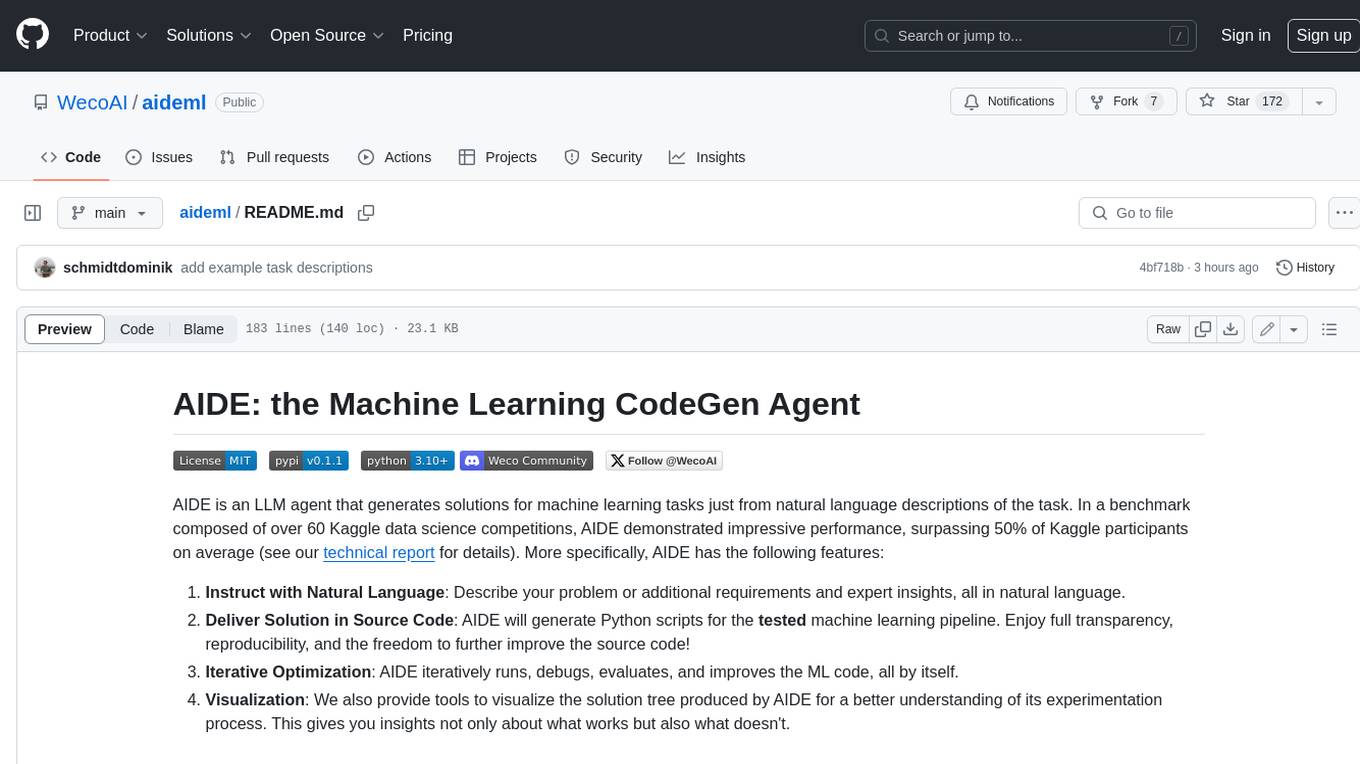
AIDE is a machine learning code generation agent that can generate solutions for machine learning tasks from natural language descriptions. It has the following features: 1. **Instruct with Natural Language**: Describe your problem or additional requirements and expert insights, all in natural language. 2. **Deliver Solution in Source Code**: AIDE will generate Python scripts for the **tested** machine learning pipeline. Enjoy full transparency, reproducibility, and the freedom to further improve the source code! 3. **Iterative Optimization**: AIDE iteratively runs, debugs, evaluates, and improves the ML code, all by itself. 4. **Visualization**: We also provide tools to visualize the solution tree produced by AIDE for a better understanding of its experimentation process. This gives you insights not only about what works but also what doesn't. AIDE has been benchmarked on over 60 Kaggle data science competitions and has demonstrated impressive performance, surpassing 50% of Kaggle participants on average. It is particularly well-suited for tasks that require complex data preprocessing, feature engineering, and model selection.
README:
AIDE is an LLM agent that generates solutions for machine learning tasks just from natural language descriptions of the task. In a benchmark composed of over 60 Kaggle data science competitions, AIDE demonstrated impressive performance, surpassing 50% of Kaggle participants on average (see our technical report for details). More specifically, AIDE has the following features:
- Instruct with Natural Language: Describe your problem or additional requirements and expert insights, all in natural language.
- Deliver Solution in Source Code: AIDE will generate Python scripts for the tested machine learning pipeline. Enjoy full transparency, reproducibility, and the freedom to further improve the source code!
- Iterative Optimization: AIDE iteratively runs, debugs, evaluates, and improves the ML code, all by itself.
- Visualization: We also provide tools to visualize the solution tree produced by AIDE for a better understanding of its experimentation process. This gives you insights not only about what works but also what doesn't.
Make sure you have Python>=3.10 installed and run:
pip install -U aidemlAlso install unzip to allow the agent to autonomously extract your data.
Set up your OpenAI (or Anthropic) API key:
export OPENAI_API_KEY=<your API key>
# or
export ANTHROPIC_API_KEY=<your API key>To run AIDE:
aide data_dir="<path to your data directory>" goal="<describe the agent's goal for your task>" eval="<(optional) describe the evaluation metric the agent should use>"For example, to run AIDE on the example house price prediction task:
aide data_dir="example_tasks/house_prices" goal="Predict the sales price for each house" eval="Use the RMSE metric between the logarithm of the predicted and observed values."Options:
-
data_dir(required): a directory containing all the data relevant for your task (.csvfiles, images, etc.). -
goal: describe what you want the models to predict in your task, for example, "Build a timeseries forcasting model for bitcoin close price" or "Predict sales price for houses". -
eval: the evaluation metric used to evaluate the ML models for the task (e.g., accuracy, F1, Root-Mean-Squared-Error, etc.)
Alternatively, you can provide the entire task description as a desc_str string, or write it in a plaintext file and pass its path as desc_file (example file).
aide data_dir="my_data_dir" desc_file="my_task_description.txt"The result of the run will be stored in the logs directory.
-
logs/<experiment-id>/best_solution.py: Python code of best solution according to the validation metric -
logs/<experiment-id>/journal.json: a JSON file containing the metadata of the experiment runs, including all the code generated in intermediate steps, plan, evaluation results, etc. -
logs/<experiment-id>/tree_plot.html: you can open it in your browser. It contains visualization of solution tree, which details the experimentation process of finding and optimizing ML code. You can explore and interact with the tree visualization to view what plan and code AIDE comes up with in each step.
The workspaces directory will contain all the files and data that the agent generated.
To further customize the behaviour of AIDE, some useful options might be:
-
agent.code.model=...to configure which model the agent should use for coding (default isgpt-4-turbo) -
agent.steps=...to configure how many improvement iterations the agent should run (default is 20) -
agent.search.num_drafts=...to configure the number of initial drafts the agent should generate (default is 5)
You can check the config.yaml file for more options.
Using AIDE within your Python script/project is easy. Follow the setup steps above, and then create an AIDE experiment like below and start running:
import aide
exp = aide.Experiment(
data_dir="example_tasks/bitcoin_price", # replace this with your own directory
goal="Build a timeseries forcasting model for bitcoin close price.", # replace with your own goal description
eval="RMSLE" # replace with your own evaluation metric
)
best_solution = exp.run(steps=10)
print(f"Best solution has validation metric: {best_solution.valid_metric}")
print(f"Best solution code: {best_solution.code}")To install AIDE for development, clone this repository and install it locally.
git clone https://github.com/WecoAI/aideml.git
cd aideml
pip install -e .Contribution guide will be available soon.
AIDE's problem-solving approach is inspired by how human data scientists tackle challenges. It starts by generating a set of initial solution drafts and then iteratively refines and improves them based on performance feedback. This process is driven by a technique we call Solution Space Tree Search.
At its core, Solution Space Tree Search consists of three main components:
- Solution Generator: This component proposes new solutions by either creating novel drafts or making changes to existing solutions, such as fixing bugs or introducing improvements.
- Evaluator: The evaluator assesses the quality of each proposed solution by running it and comparing its performance against the objective. This is implemented by instructing the LLM to include statements that print the evaluation metric and by having another LLM parse the printed logs to extract the evaluation metric.
- Base Solution Selector: The solution selector picks the most promising solution from the explored options to serve as the starting point for the next iteration of refinement.
By repeatedly applying these steps, AIDE navigates the vast space of possible solutions, progressively refining its approach until it converges on the optimal solution for the given data science problem.
| Domain | Task | Top% | Solution Link | Competition Link |
|---|---|---|---|---|
| Urban Planning | Forecast city bikeshare system usage | 5% | link | link |
| Physics | Predicting Critical Heat Flux | 56% | link | link |
| Genomics | Classify bacteria species from genomic data | 0% | link | link |
| Agriculture | Predict blueberry yield | 58% | link | link |
| Healthcare | Predict disease prognosis | 0% | link | link |
| Economics | Predict monthly microbusiness density in a given area | 35% | link | link |
| Cryptography | Decrypt shakespearean text | 91% | link | link |
| Data Science Education | Predict passenger survival on Titanic | 78% | link | link |
| Software Engineering | Predict defects in c programs given various attributes about the code | 0% | link | link |
| Real Estate | Predict the final price of homes | 5% | link | link |
| Real Estate | Predict house sale price | 36% | link | link |
| Entertainment Analytics | Predict movie worldwide box office revenue | 62% | link | link |
| Entertainment Analytics | Predict scoring probability in next 10 seconds of a rocket league match | 21% | link | link |
| Environmental Science | Predict air pollution levels | 12% | link | link |
| Environmental Science | Classify forest categories using cartographic variables | 55% | link | link |
| Computer Vision | Predict the probability of machine failure | 32% | link | link |
| Computer Vision | Identify handwritten digits | 14% | link | link |
| Manufacturing | Predict missing values in dataset | 70% | link | link |
| Manufacturing | Predict product failures | 48% | link | link |
| Manufacturing | Cluster control data into different control states | 96% | link | link |
| Natural Language Processing | Classify toxic online comments | 78% | link | link |
| Natural Language Processing | Predict passenger transport to an alternate dimension | 59% | link | link |
| Natural Language Processing | Classify sentence sentiment | 42% | link | link |
| Natural Language Processing | Predict whether a tweet is about a real disaster | 48% | link | link |
| Business Analytics | Predict total sales for each product and store in the next month | 87% | link | link |
| Business Analytics | Predict book sales for 2021 | 66% | link | link |
| Business Analytics | Predict insurance claim amount | 80% | link | link |
| Business Analytics | Minimize penalty cost in scheduling families to santa's workshop | 100% | link | link |
| Business Analytics | Predict yearly sales for learning modules | 26% | link | link |
| Business Analytics | Binary classification of manufacturing machine state | 60% | link | link |
| Business Analytics | Forecast retail store sales | 36% | link | link |
| Business Analytics | Predict reservation cancellation | 54% | link | link |
| Finance | Predict the probability of an insurance claim | 13% | link | link |
| Finance | Predict loan loss | 0% | link | link |
| Finance | Predict a continuous target | 42% | link | link |
| Finance | Predict customer churn | 24% | link | link |
| Finance | Predict median house value | 58% | link | link |
| Finance | Predict closing price movements for nasdaq listed stocks | 99% | link | link |
| Finance | Predict taxi fare | 100% | link | link |
| Finance | Predict insurance claim probability | 62% | link | link |
| Biotech | Predict cat in dat | 66% | link | link |
| Biotech | Predict the biological response of molecules | 62% | link | link |
| Biotech | Predict medical conditions | 92% | link | link |
| Biotech | Predict wine quality | 61% | link | link |
| Biotech | Predict binary target without overfitting | 98% | link | link |
| Biotech | Predict concrete strength | 86% | link | link |
| Biotech | Predict crab age | 46% | link | link |
| Biotech | Predict enzyme characteristics | 10% | link | link |
| Biotech | Classify activity state from sensor data | 51% | link | link |
| Biotech | Predict horse health outcomes | 86% | link | link |
| Biotech | Predict the mohs hardness of a mineral | 64% | link | link |
| Biotech | Predict cirrhosis patient outcomes | 51% | link | link |
| Biotech | Predict obesity risk | 62% | link | link |
| Biotech | Classify presence of feature in data | 66% | link | link |
| Biotech | Predict patient's smoking status | 40% | link | link |
For Tasks:
Click tags to check more tools for each tasksFor Jobs:
Alternative AI tools for aideml
Similar Open Source Tools

aideml
AIDE is a machine learning code generation agent that can generate solutions for machine learning tasks from natural language descriptions. It has the following features: 1. **Instruct with Natural Language**: Describe your problem or additional requirements and expert insights, all in natural language. 2. **Deliver Solution in Source Code**: AIDE will generate Python scripts for the **tested** machine learning pipeline. Enjoy full transparency, reproducibility, and the freedom to further improve the source code! 3. **Iterative Optimization**: AIDE iteratively runs, debugs, evaluates, and improves the ML code, all by itself. 4. **Visualization**: We also provide tools to visualize the solution tree produced by AIDE for a better understanding of its experimentation process. This gives you insights not only about what works but also what doesn't. AIDE has been benchmarked on over 60 Kaggle data science competitions and has demonstrated impressive performance, surpassing 50% of Kaggle participants on average. It is particularly well-suited for tasks that require complex data preprocessing, feature engineering, and model selection.
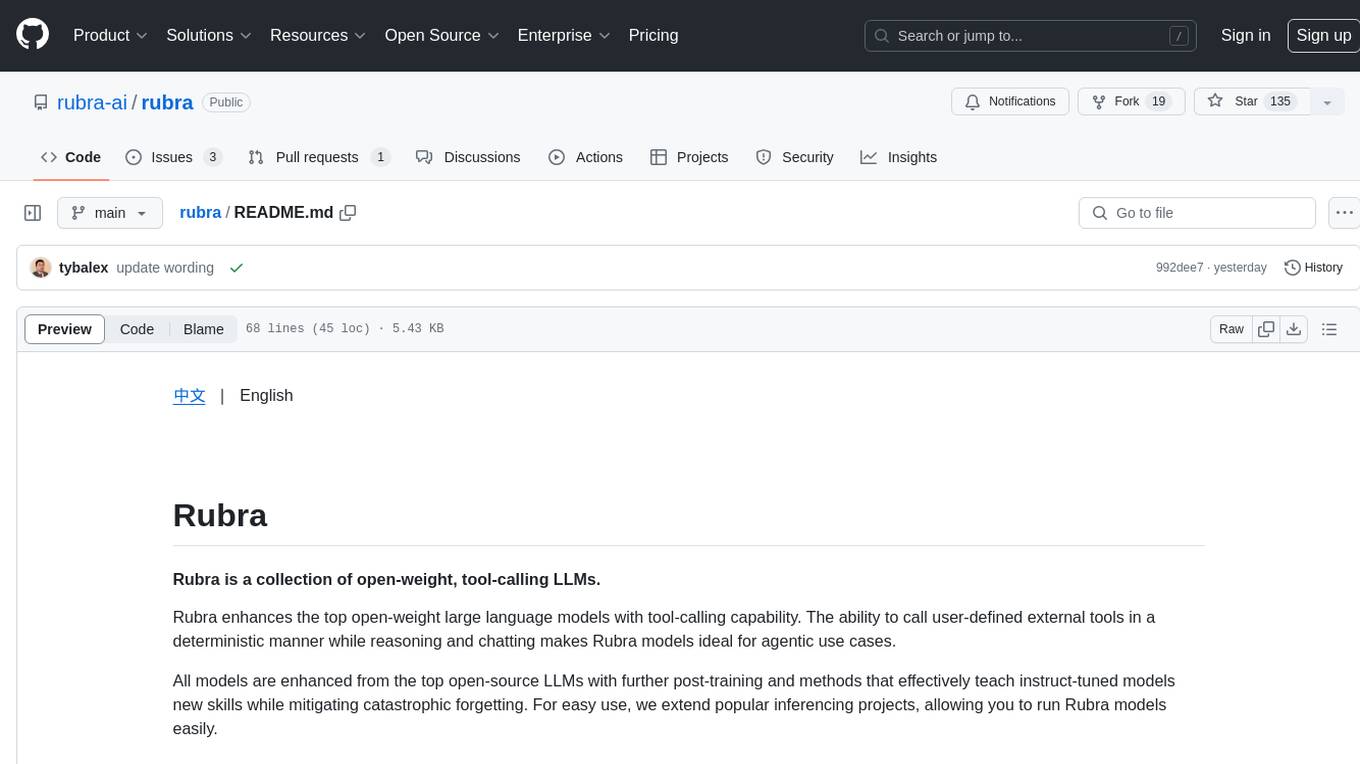
rubra
Rubra is a collection of open-weight large language models enhanced with tool-calling capability. It allows users to call user-defined external tools in a deterministic manner while reasoning and chatting, making it ideal for agentic use cases. The models are further post-trained to teach instruct-tuned models new skills and mitigate catastrophic forgetting. Rubra extends popular inferencing projects for easy use, enabling users to run the models easily.
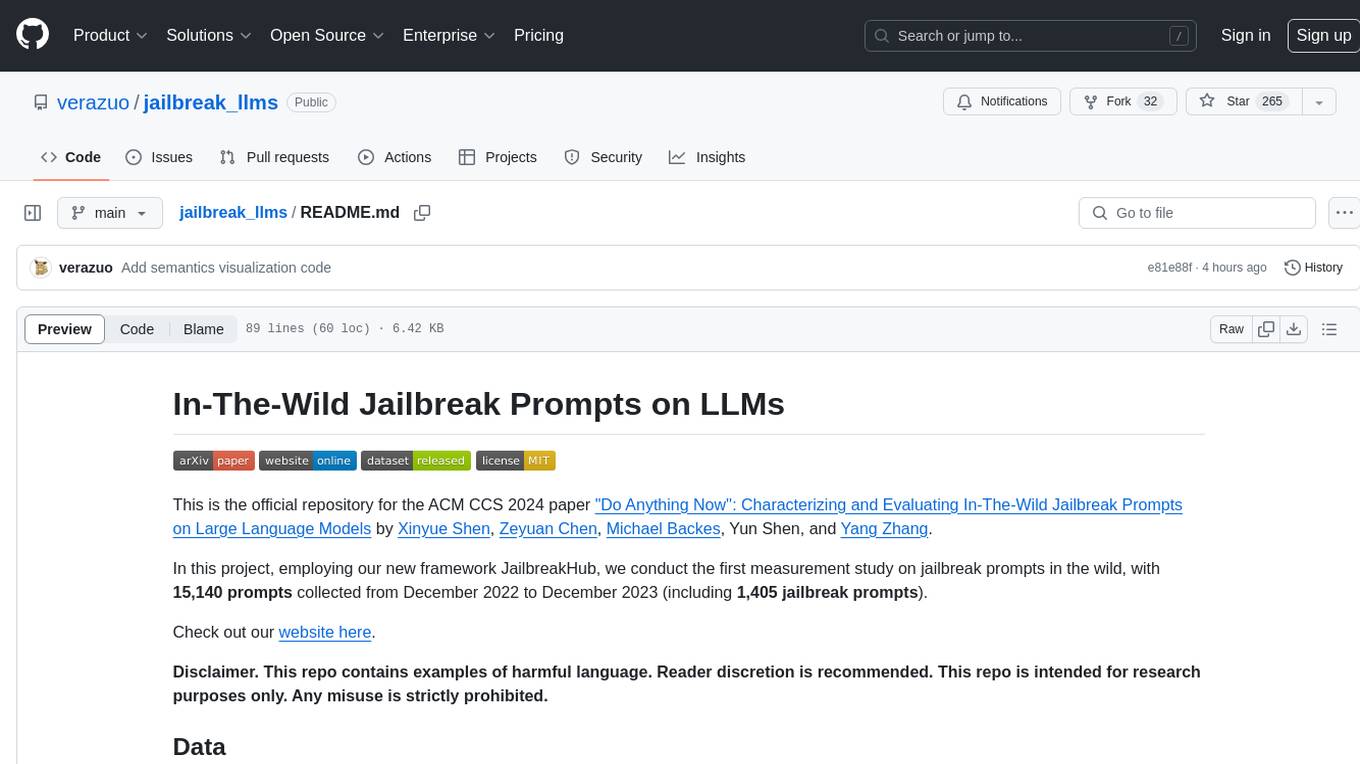
jailbreak_llms
This is the official repository for the ACM CCS 2024 paper 'Do Anything Now': Characterizing and Evaluating In-The-Wild Jailbreak Prompts on Large Language Models. The project employs a new framework called JailbreakHub to conduct the first measurement study on jailbreak prompts in the wild, collecting 15,140 prompts from December 2022 to December 2023, including 1,405 jailbreak prompts. The dataset serves as the largest collection of in-the-wild jailbreak prompts. The repository contains examples of harmful language and is intended for research purposes only.
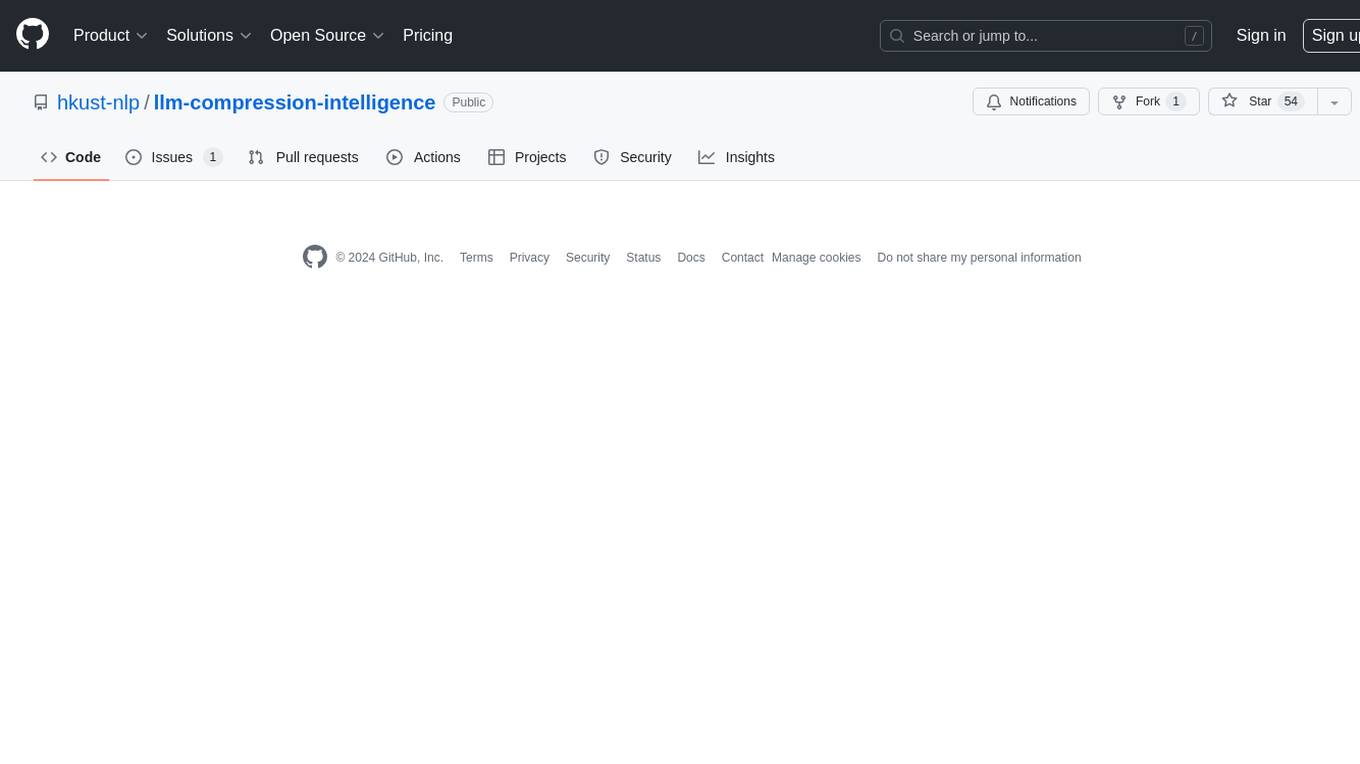
llm-compression-intelligence
This repository presents the findings of the paper "Compression Represents Intelligence Linearly". The study reveals a strong linear correlation between the intelligence of LLMs, as measured by benchmark scores, and their ability to compress external text corpora. Compression efficiency, derived from raw text corpora, serves as a reliable evaluation metric that is linearly associated with model capabilities. The repository includes the compression corpora used in the paper, code for computing compression efficiency, and data collection and processing pipelines.
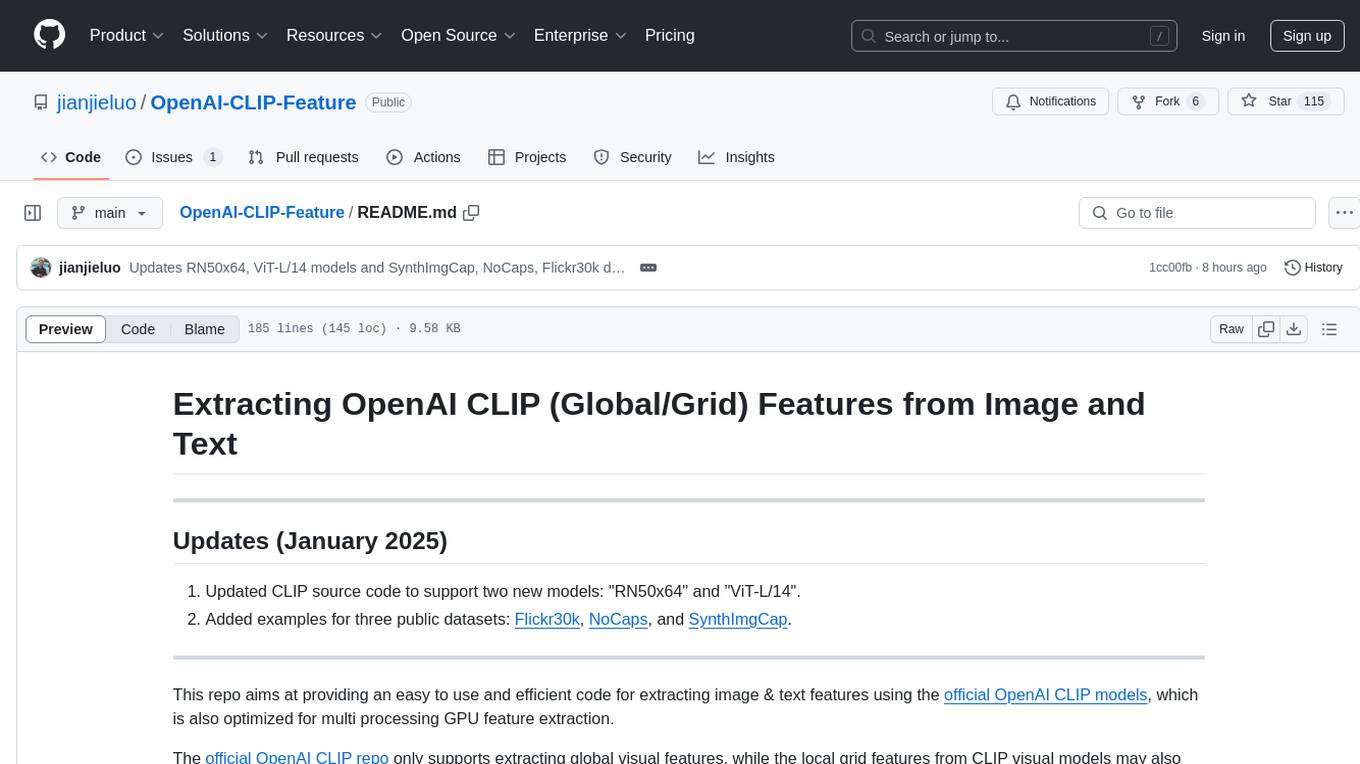
OpenAI-CLIP-Feature
This repository provides code for extracting image and text features using OpenAI CLIP models, supporting both global and local grid visual features. It aims to facilitate multi visual-and-language downstream tasks by allowing users to customize input and output grid resolution easily. The extracted features have shown comparable or superior results in image captioning tasks without hyperparameter tuning. The repo supports various CLIP models and provides detailed information on supported settings and results on MSCOCO image captioning. Users can get started by setting up experiments with the extracted features using X-modaler.
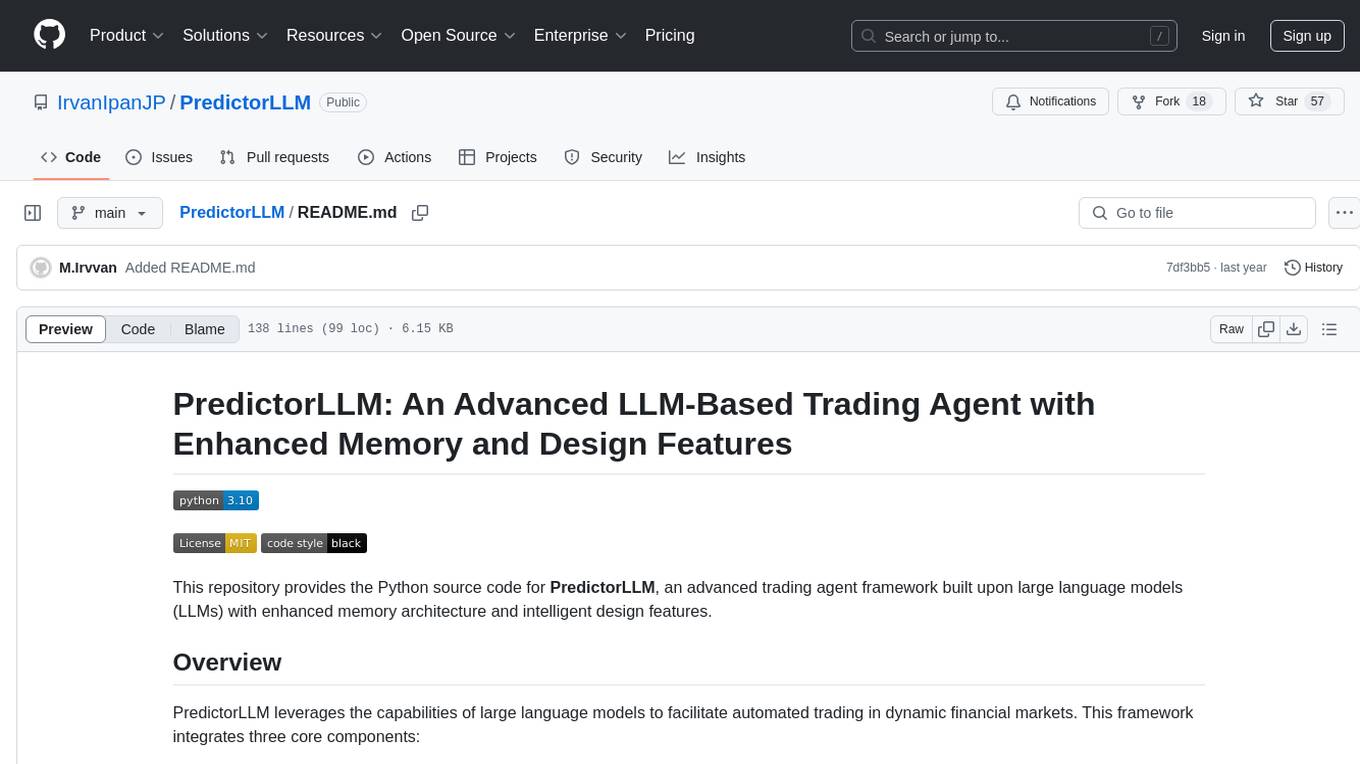
PredictorLLM
PredictorLLM is an advanced trading agent framework that utilizes large language models to automate trading in financial markets. It includes a profiling module to establish agent characteristics, a layered memory module for retaining and prioritizing financial data, and a decision-making module to convert insights into trading strategies. The framework mimics professional traders' behavior, surpassing human limitations in data processing and continuously evolving to adapt to market conditions for superior investment outcomes.
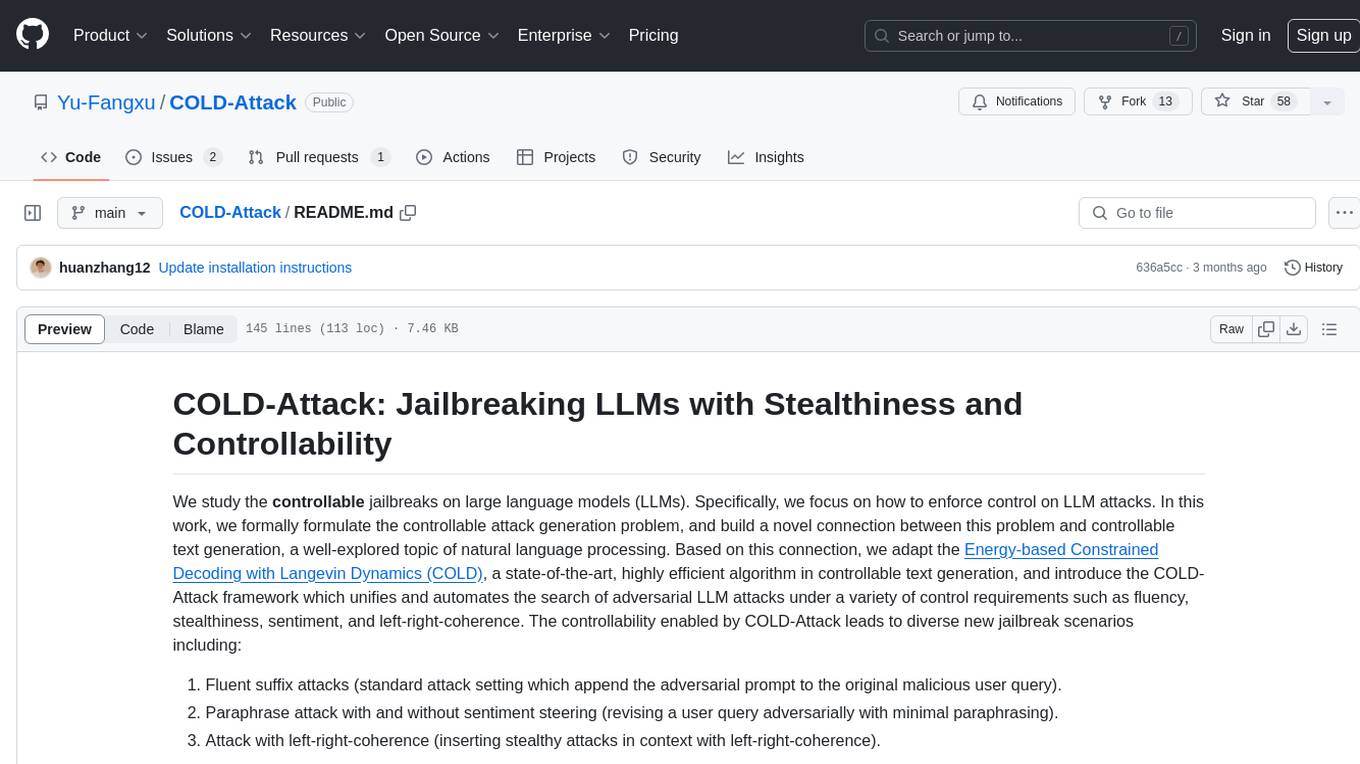
COLD-Attack
COLD-Attack is a framework designed for controllable jailbreaks on large language models (LLMs). It formulates the controllable attack generation problem and utilizes the Energy-based Constrained Decoding with Langevin Dynamics (COLD) algorithm to automate the search of adversarial LLM attacks with control over fluency, stealthiness, sentiment, and left-right-coherence. The framework includes steps for energy function formulation, Langevin dynamics sampling, and decoding process to generate discrete text attacks. It offers diverse jailbreak scenarios such as fluent suffix attacks, paraphrase attacks, and attacks with left-right-coherence.
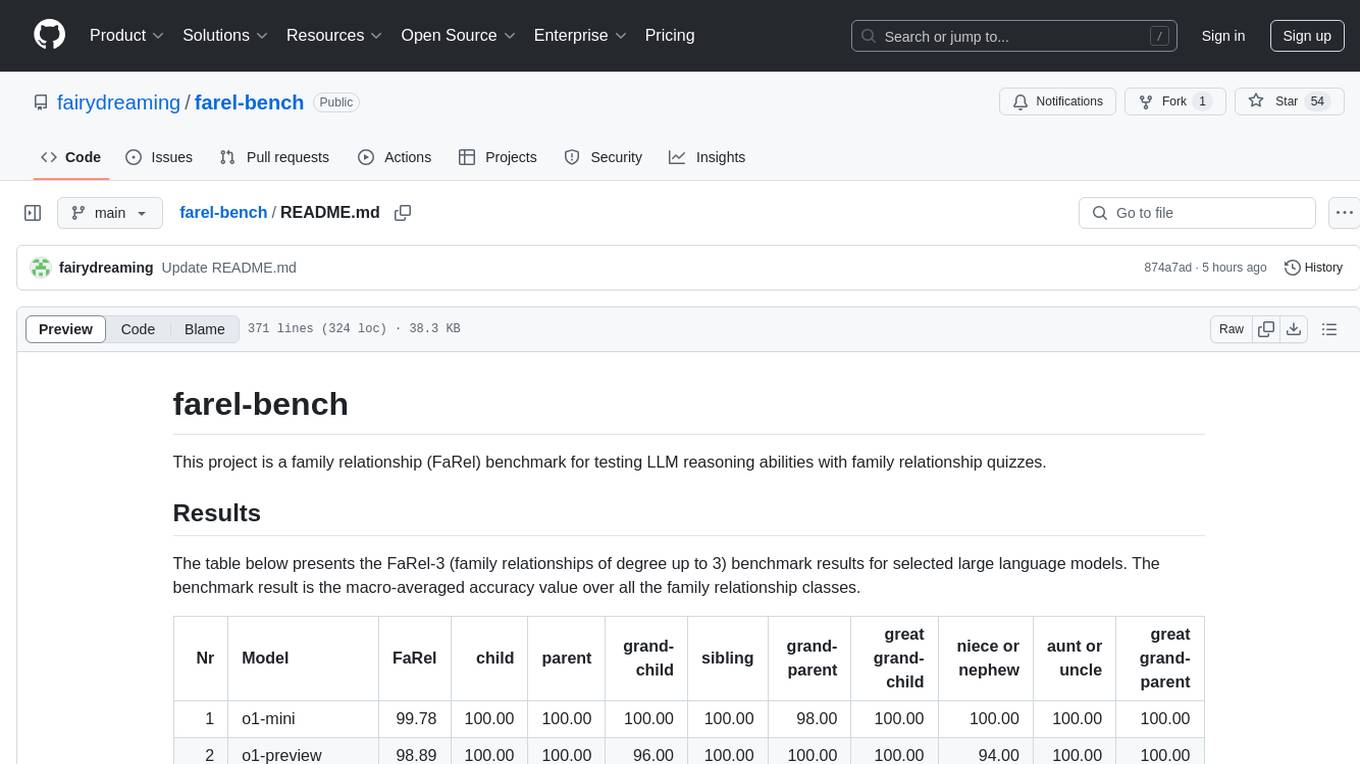
farel-bench
The 'farel-bench' project is a benchmark tool for testing LLM reasoning abilities with family relationship quizzes. It generates quizzes based on family relationships of varying degrees and measures the accuracy of large language models in solving these quizzes. The project provides scripts for generating quizzes, running models locally or via APIs, and calculating benchmark metrics. The quizzes are designed to test logical reasoning skills using family relationship concepts, with the goal of evaluating the performance of language models in this specific domain.
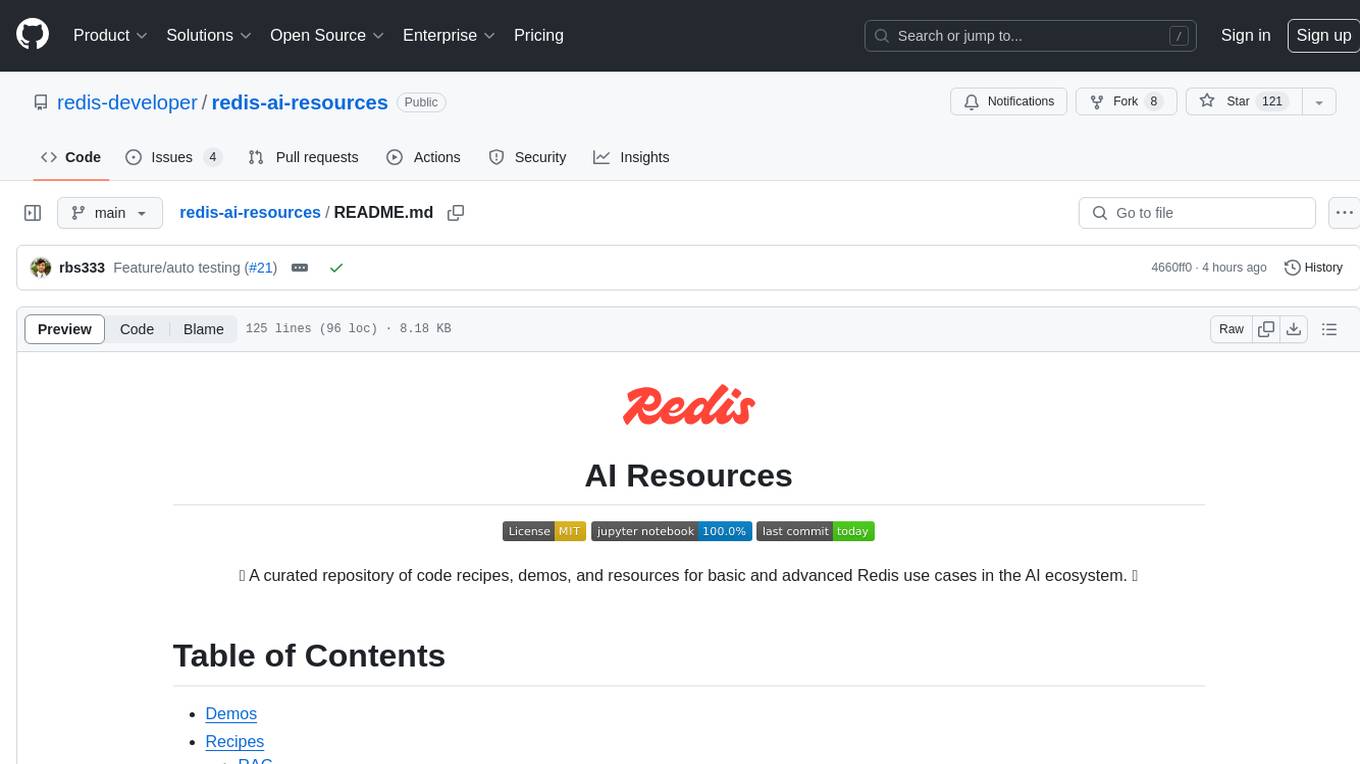
redis-ai-resources
A curated repository of code recipes, demos, and resources for basic and advanced Redis use cases in the AI ecosystem. It includes demos for ArxivChatGuru, Redis VSS, Vertex AI & Redis, Agentic RAG, ArXiv Search, and Product Search. Recipes cover topics like Getting started with RAG, Semantic Cache, Advanced RAG, and Recommendation systems. The repository also provides integrations/tools like RedisVL, AWS Bedrock, LangChain Python, LangChain JS, LlamaIndex, Semantic Kernel, RelevanceAI, and DocArray. Additional content includes blog posts, talks, reviews, and documentation related to Vector Similarity Search, AI-Powered Document Search, Vector Databases, Real-Time Product Recommendations, and more. Benchmarks compare Redis against other Vector Databases and ANN benchmarks. Documentation includes QuickStart guides, official literature for Vector Similarity Search, Redis-py client library docs, Redis Stack documentation, and Redis client list.
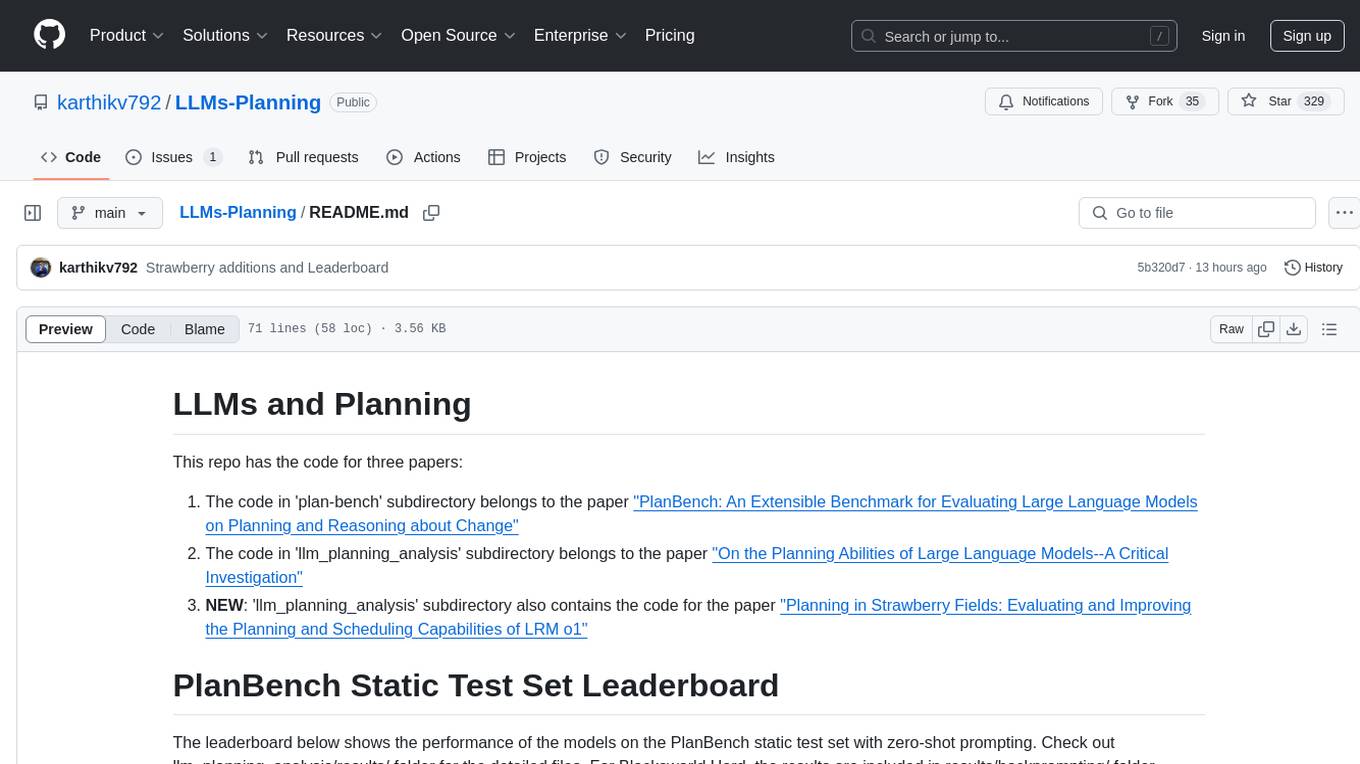
LLMs-Planning
This repository contains code for three papers related to evaluating large language models on planning and reasoning about change. It includes benchmarking tools and analysis for assessing the planning abilities of large language models. The latest addition evaluates and enhances the planning and scheduling capabilities of a specific language reasoning model. The repository provides a static test set leaderboard showcasing model performance on various tasks with natural language and planning domain prompts.
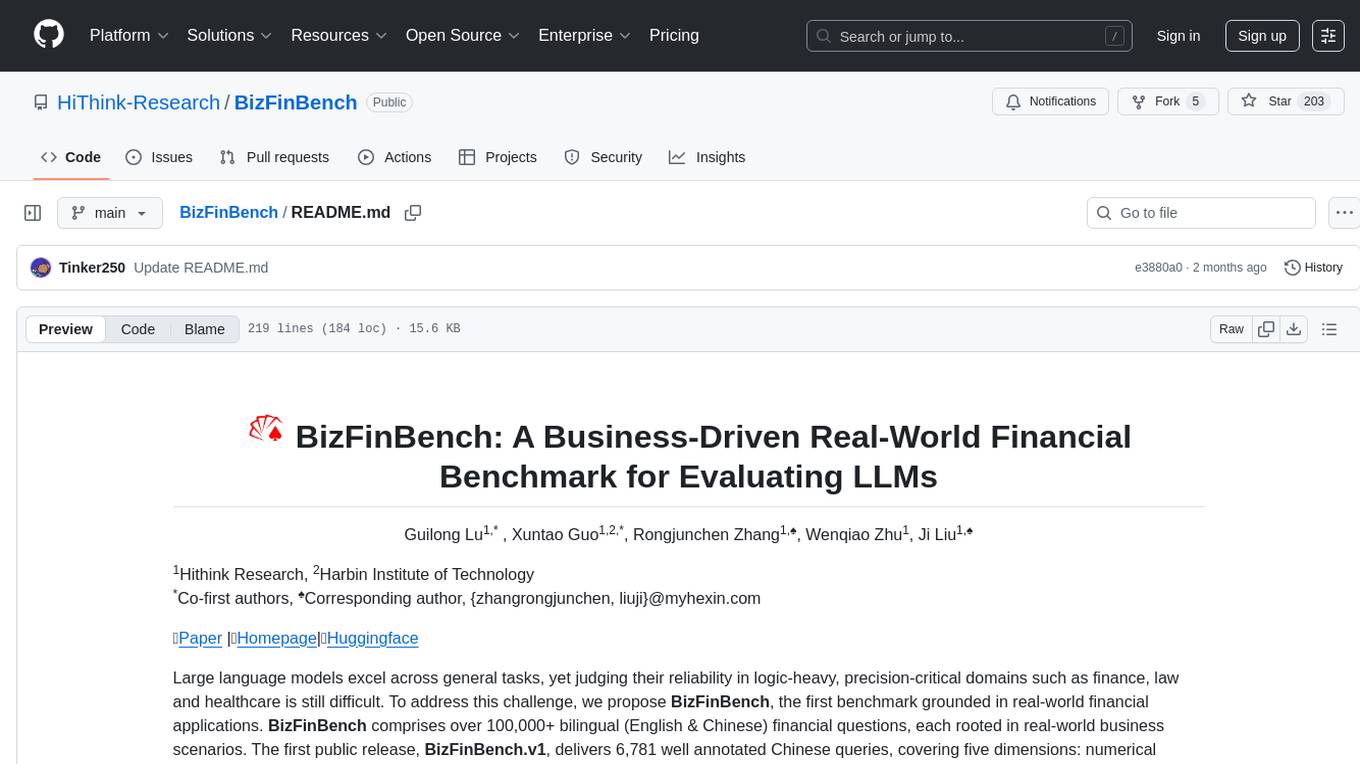
BizFinBench
BizFinBench is a benchmark tool designed for evaluating large language models (LLMs) in logic-heavy and precision-critical domains such as finance. It comprises over 100,000 bilingual financial questions rooted in real-world business scenarios. The tool covers five dimensions: numerical calculation, reasoning, information extraction, prediction recognition, and knowledge-based question answering, mapped to nine fine-grained categories. BizFinBench aims to assess the capacity of LLMs in real-world financial scenarios and provides insights into their strengths and limitations.
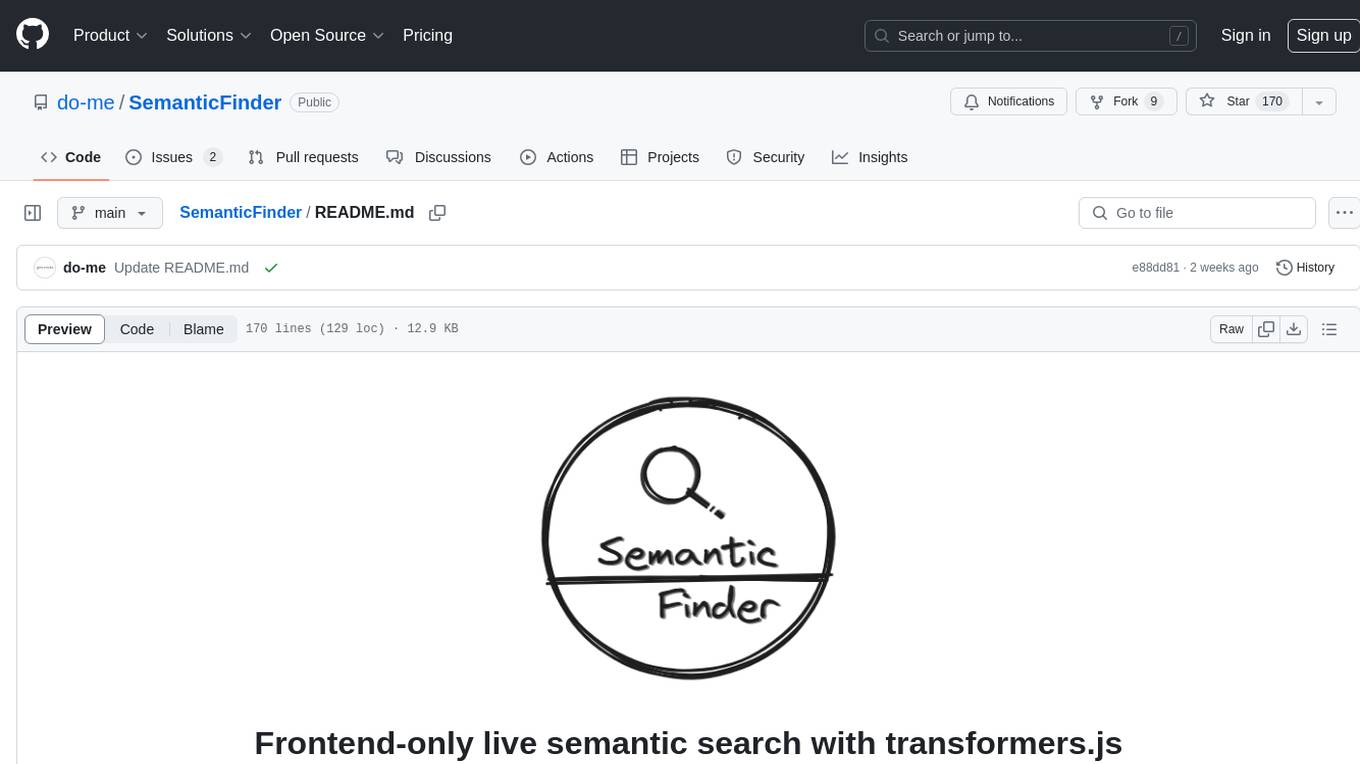
SemanticFinder
SemanticFinder is a frontend-only live semantic search tool that calculates embeddings and cosine similarity client-side using transformers.js and SOTA embedding models from Huggingface. It allows users to search through large texts like books with pre-indexed examples, customize search parameters, and offers data privacy by keeping input text in the browser. The tool can be used for basic search tasks, analyzing texts for recurring themes, and has potential integrations with various applications like wikis, chat apps, and personal history search. It also provides options for building browser extensions and future ideas for further enhancements and integrations.
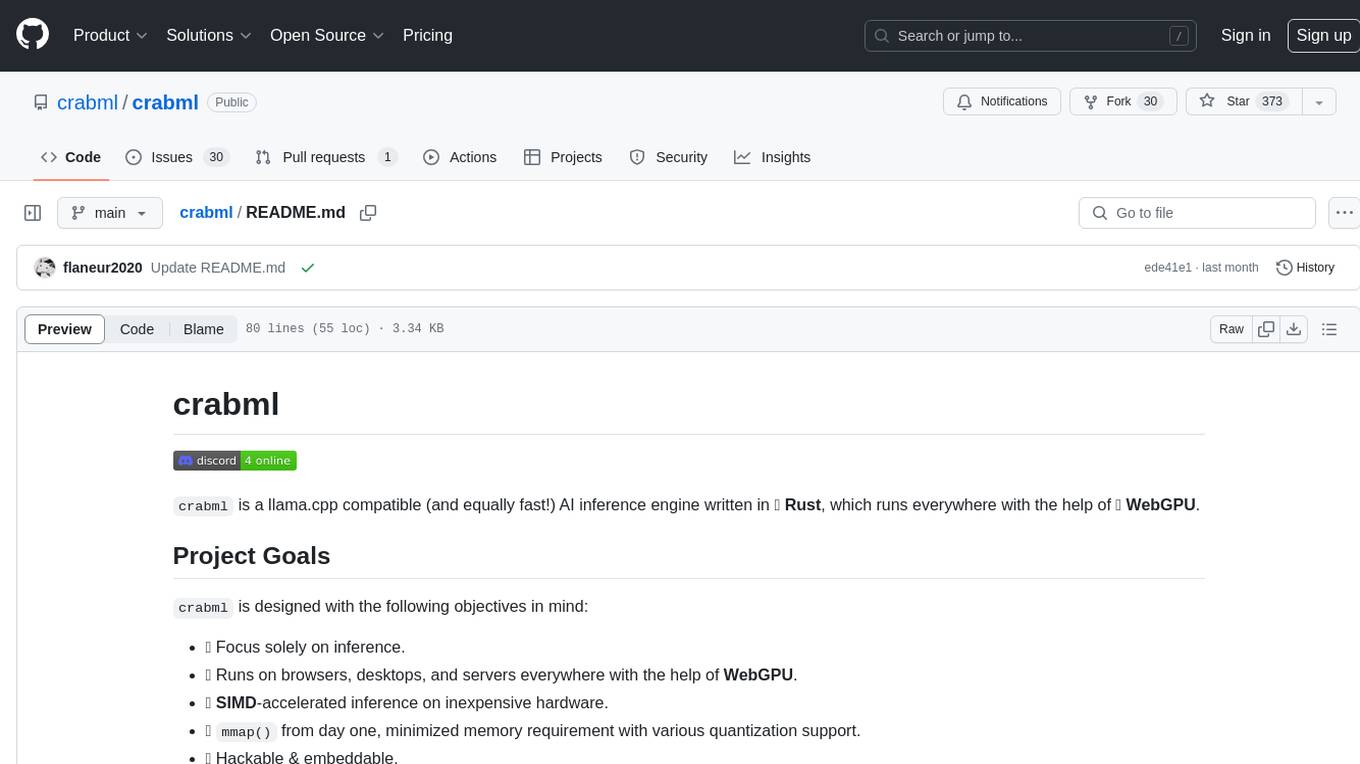
crabml
Crabml is a llama.cpp compatible AI inference engine written in Rust, designed for efficient inference on various platforms with WebGPU support. It focuses on running inference tasks with SIMD acceleration and minimal memory requirements, supporting multiple models and quantization methods. The project is hackable, embeddable, and aims to provide high-performance AI inference capabilities.
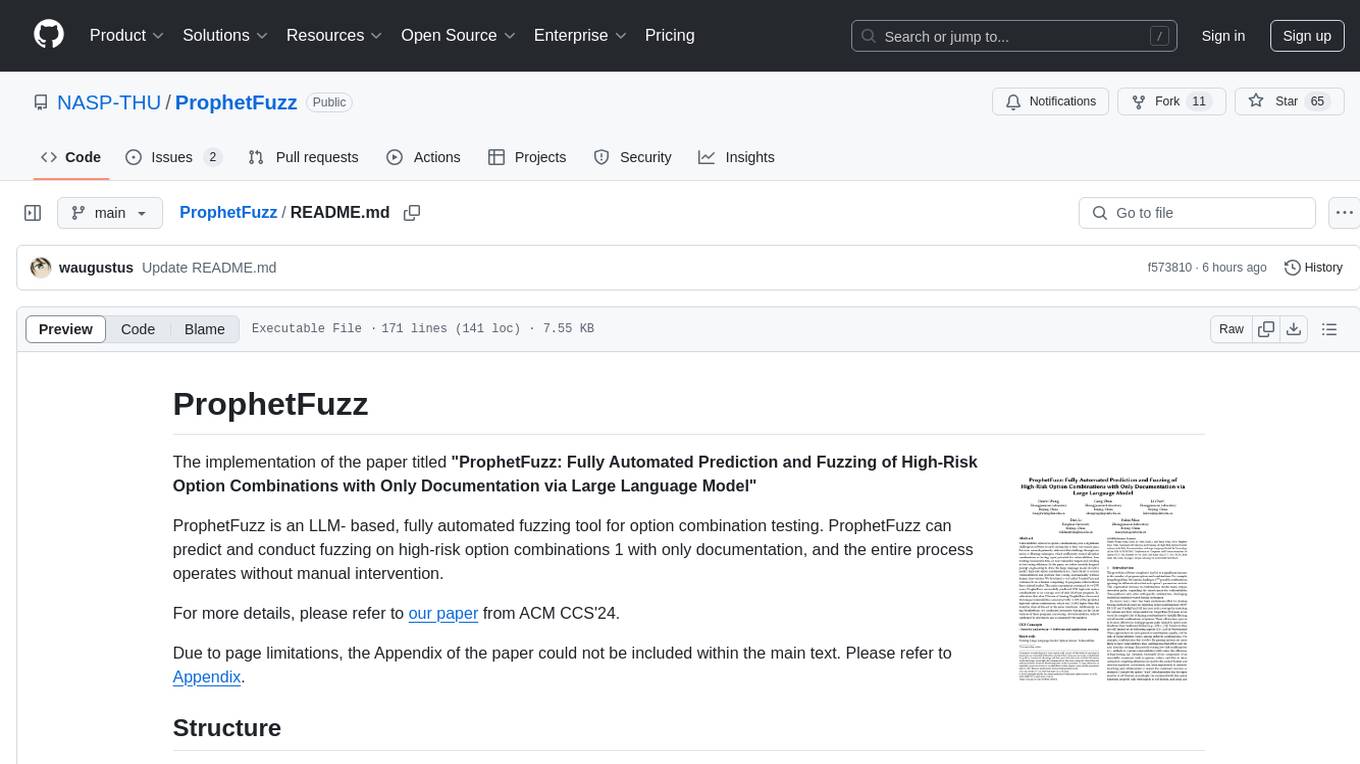
ProphetFuzz
ProphetFuzz is a fully automated fuzzing tool based on Large Language Models (LLM) for testing high-risk option combinations with only documentation. It can predict and conduct fuzzing on high-risk option combinations without manual intervention. The tool consists of components for parsing documentation, extracting constraints, predicting combinations, assembling commands, generating files, and conducting fuzzing. ProphetFuzz has been used to uncover numerous vulnerabilities in various programs, earning CVE numbers for confirmed vulnerabilities. The tool has been credited to Dawei Wang and Geng Zhou.
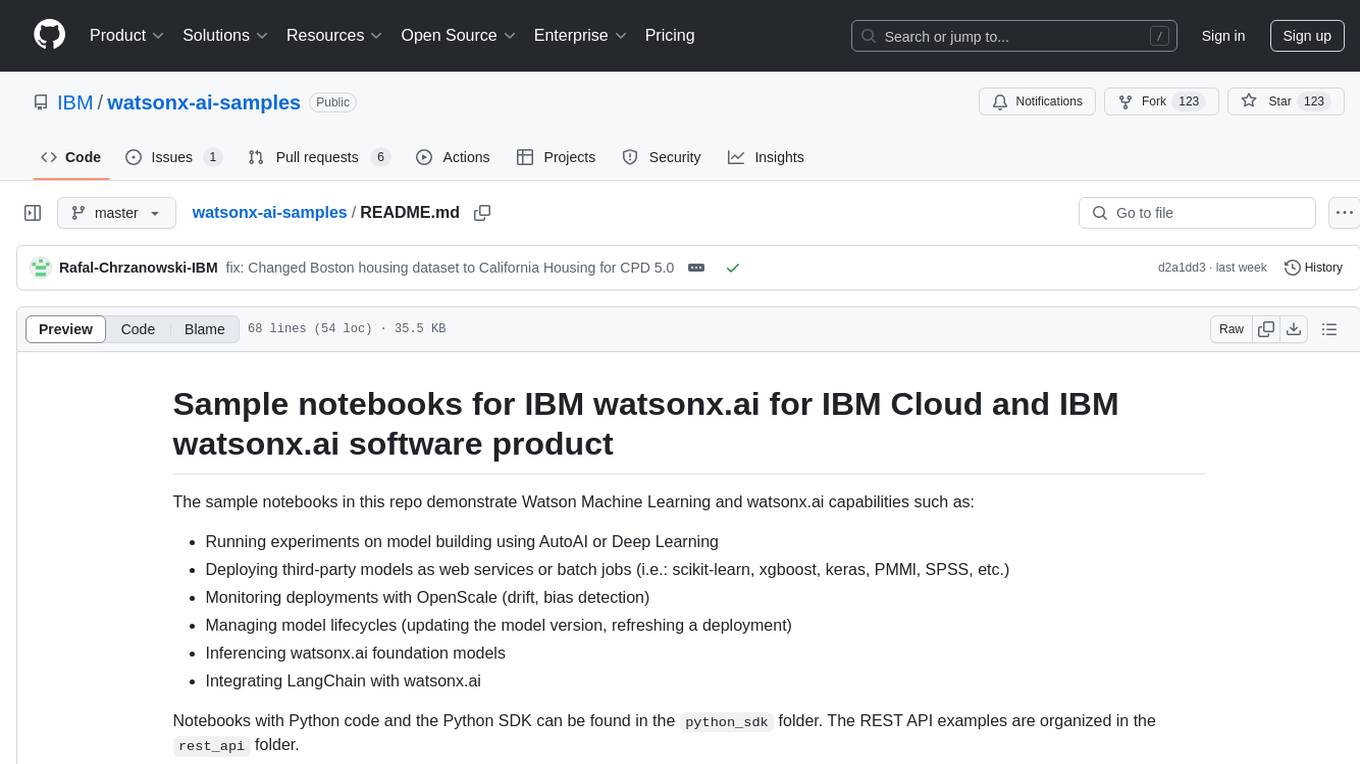
watsonx-ai-samples
Sample notebooks for IBM Watsonx.ai for IBM Cloud and IBM Watsonx.ai software product. The notebooks demonstrate capabilities such as running experiments on model building using AutoAI or Deep Learning, deploying third-party models as web services or batch jobs, monitoring deployments with OpenScale, managing model lifecycles, inferencing Watsonx.ai foundation models, and integrating LangChain with Watsonx.ai. Notebooks with Python code and the Python SDK can be found in the `python_sdk` folder. The REST API examples are organized in the `rest_api` folder.
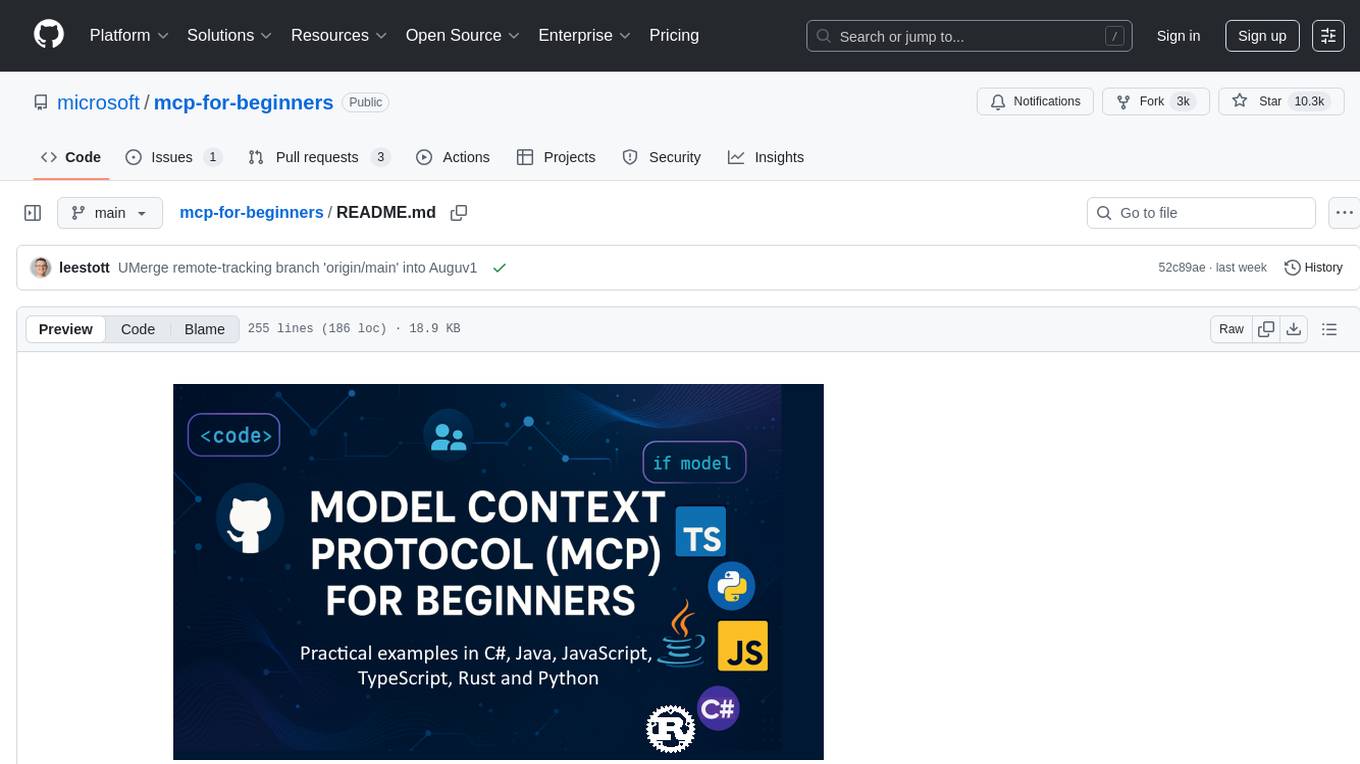
mcp-for-beginners
The Model Context Protocol (MCP) Curriculum for Beginners is an open-source framework designed to standardize interactions between AI models and client applications. It offers a structured learning path with practical coding examples and real-world use cases in popular programming languages like C#, Java, JavaScript, Rust, Python, and TypeScript. Whether you're an AI developer, system architect, or software engineer, this guide provides comprehensive resources for mastering MCP fundamentals and implementation strategies.
For similar tasks

tabby
Tabby is a self-hosted AI coding assistant, offering an open-source and on-premises alternative to GitHub Copilot. It boasts several key features: * Self-contained, with no need for a DBMS or cloud service. * OpenAPI interface, easy to integrate with existing infrastructure (e.g Cloud IDE). * Supports consumer-grade GPUs.
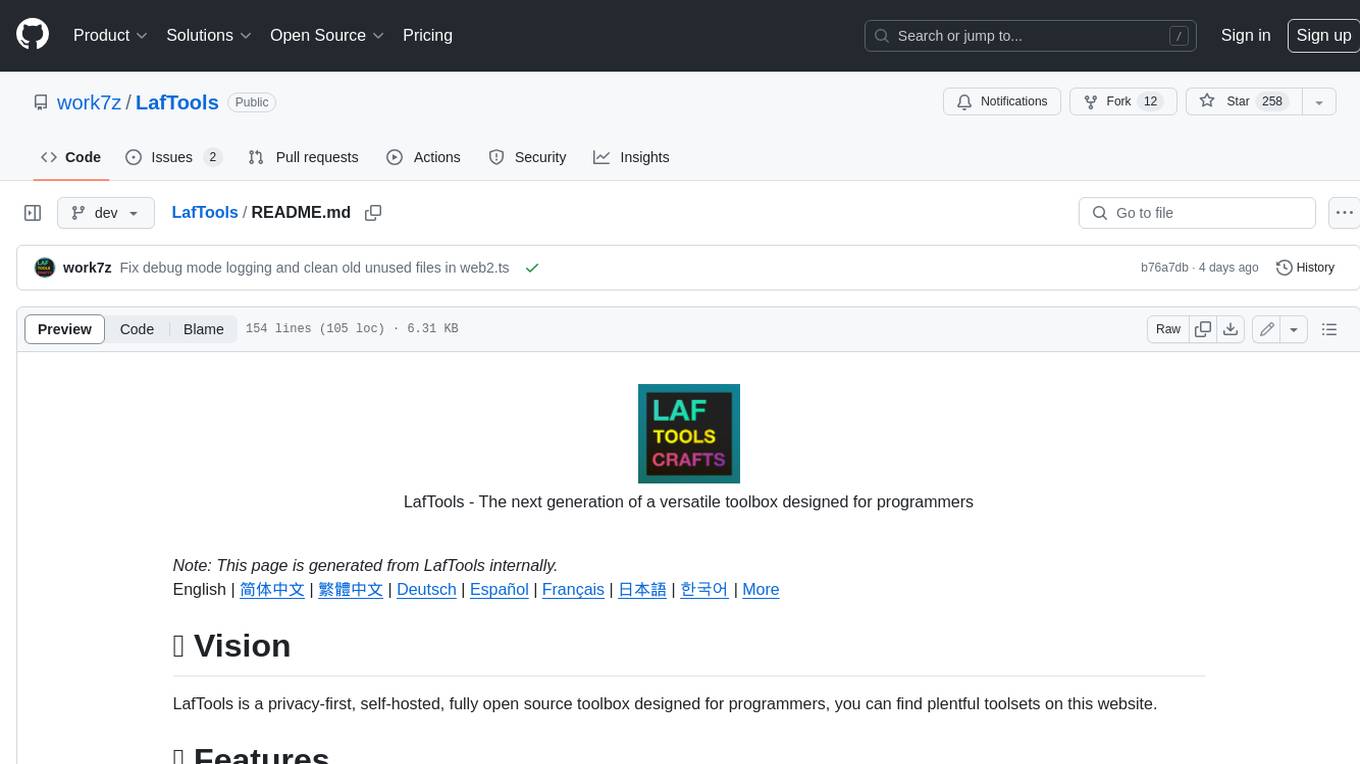
LafTools
LafTools is a privacy-first, self-hosted, fully open source toolbox designed for programmers. It offers a wide range of tools, including code generation, translation, encryption, compression, data analysis, and more. LafTools is highly integrated with a productive UI and supports full GPT-alike functionality. It is available as Docker images and portable edition, with desktop edition support planned for the future.

aideml
AIDE is a machine learning code generation agent that can generate solutions for machine learning tasks from natural language descriptions. It has the following features: 1. **Instruct with Natural Language**: Describe your problem or additional requirements and expert insights, all in natural language. 2. **Deliver Solution in Source Code**: AIDE will generate Python scripts for the **tested** machine learning pipeline. Enjoy full transparency, reproducibility, and the freedom to further improve the source code! 3. **Iterative Optimization**: AIDE iteratively runs, debugs, evaluates, and improves the ML code, all by itself. 4. **Visualization**: We also provide tools to visualize the solution tree produced by AIDE for a better understanding of its experimentation process. This gives you insights not only about what works but also what doesn't. AIDE has been benchmarked on over 60 Kaggle data science competitions and has demonstrated impressive performance, surpassing 50% of Kaggle participants on average. It is particularly well-suited for tasks that require complex data preprocessing, feature engineering, and model selection.
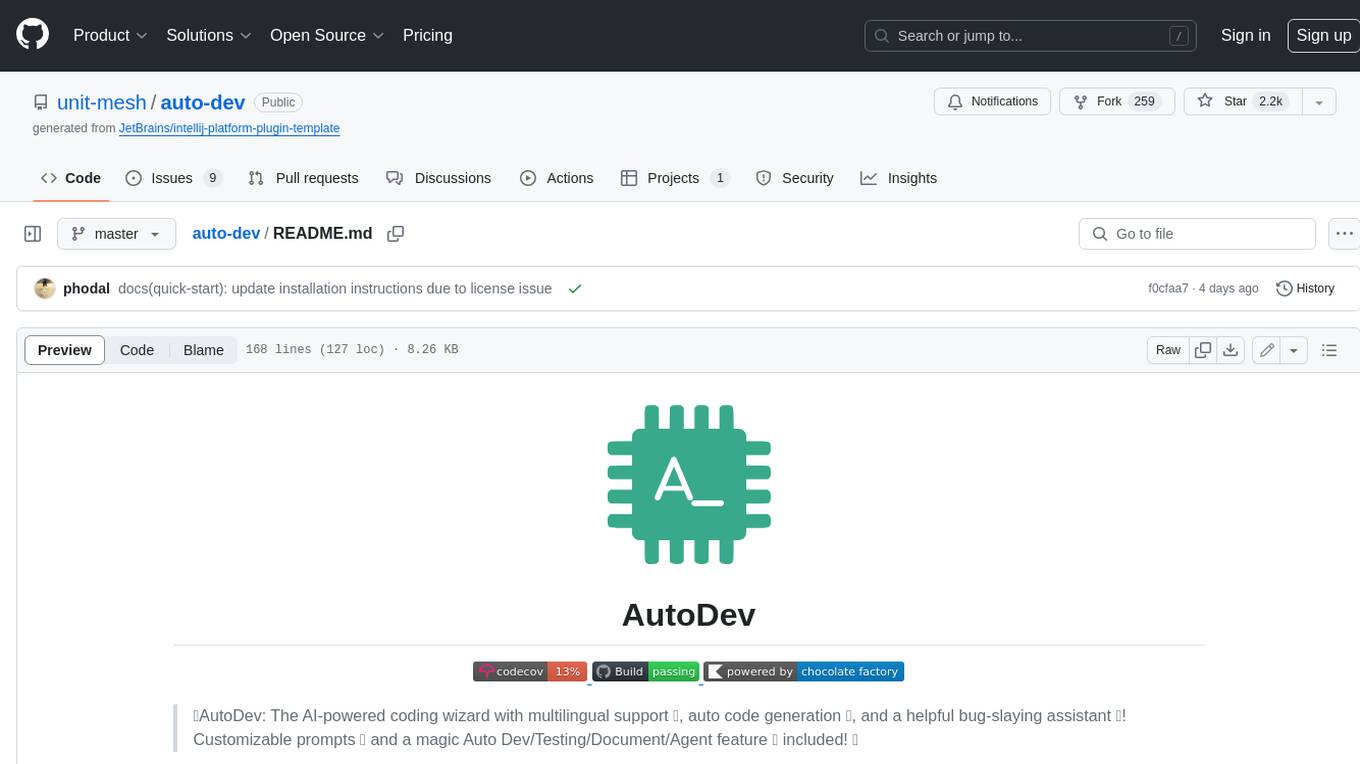
auto-dev
AutoDev is an AI-powered coding wizard that supports multiple languages, including Java, Kotlin, JavaScript/TypeScript, Rust, Python, Golang, C/C++/OC, and more. It offers a range of features, including auto development mode, copilot mode, chat with AI, customization options, SDLC support, custom AI agent integration, and language features such as language support, extensions, and a DevIns language for AI agent development. AutoDev is designed to assist developers with tasks such as auto code generation, bug detection, code explanation, exception tracing, commit message generation, code review content generation, smart refactoring, Dockerfile generation, CI/CD config file generation, and custom shell/command generation. It also provides a built-in LLM fine-tune model and supports UnitEval for LLM result evaluation and UnitGen for code-LLM fine-tune data generation.

LLM4SE
The collection is actively updated with the help of an internal literature search engine.
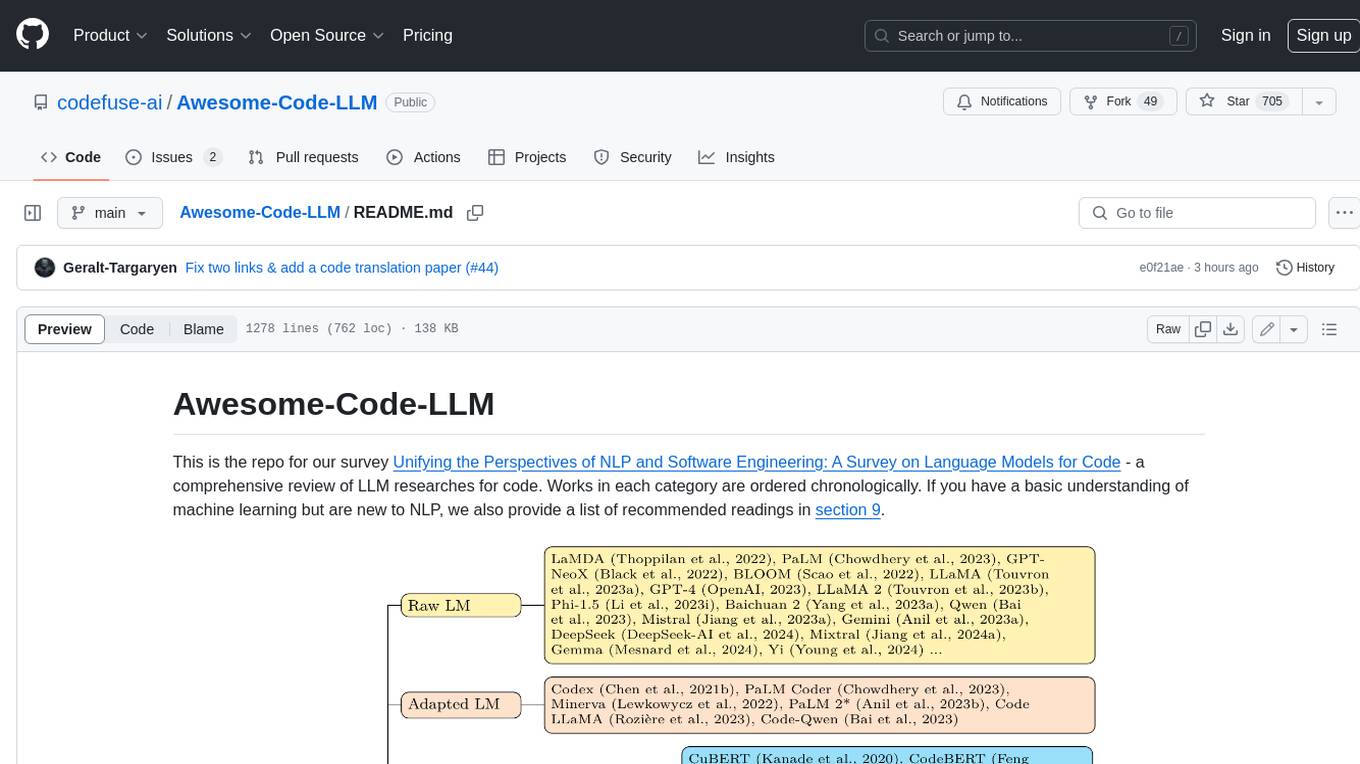
Awesome-Code-LLM
Analyze the following text from a github repository (name and readme text at end) . Then, generate a JSON object with the following keys and provide the corresponding information for each key, in lowercase letters: 'description' (detailed description of the repo, must be less than 400 words,Ensure that no line breaks and quotation marks.),'for_jobs' (List 5 jobs suitable for this tool,in lowercase letters), 'ai_keywords' (keywords of the tool,user may use those keyword to find the tool,in lowercase letters), 'for_tasks' (list of 5 specific tasks user can use this tool to do,in lowercase letters), 'answer' (in english languages)
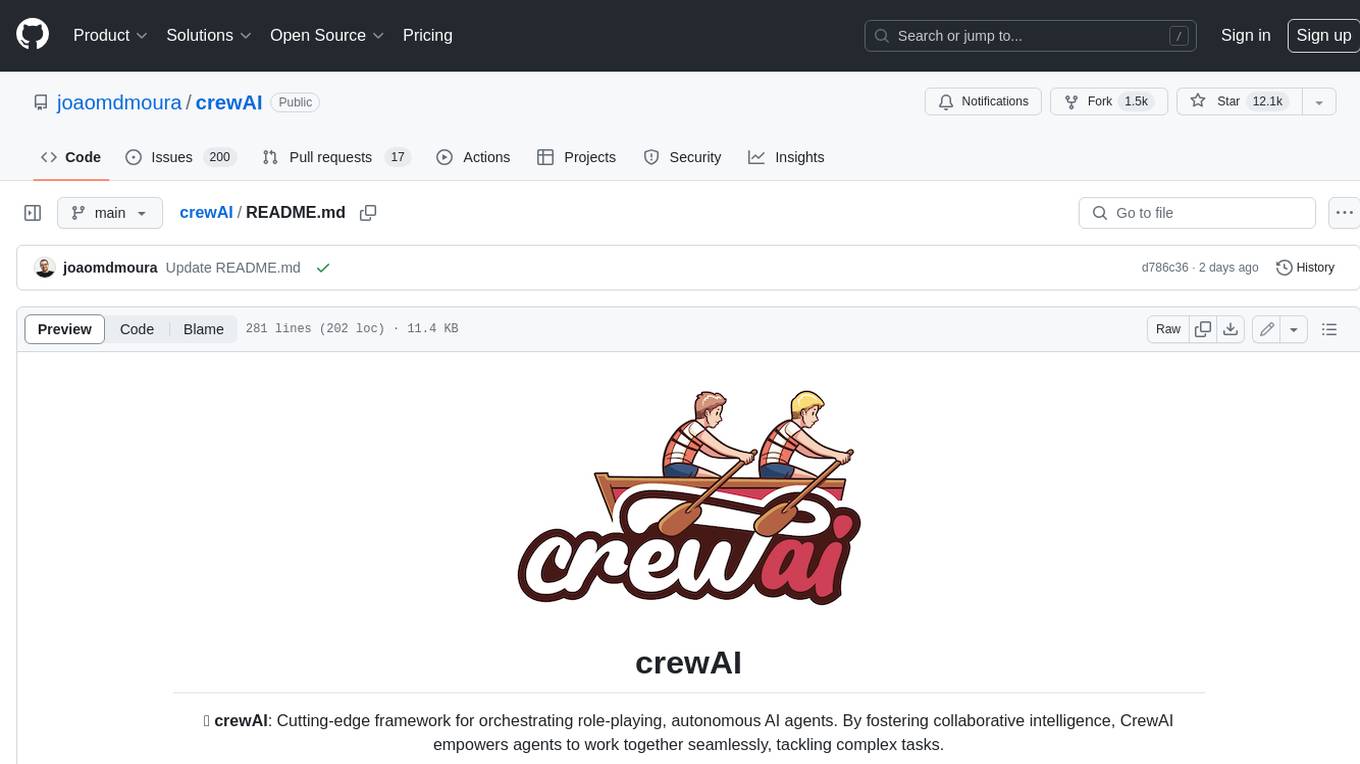
crewAI
crewAI is a cutting-edge framework for orchestrating role-playing, autonomous AI agents. By fostering collaborative intelligence, CrewAI empowers agents to work together seamlessly, tackling complex tasks. It provides a flexible and structured approach to AI collaboration, enabling users to define agents with specific roles, goals, and tools, and assign them tasks within a customizable process. crewAI supports integration with various LLMs, including OpenAI, and offers features such as autonomous task delegation, flexible task management, and output parsing. It is open-source and welcomes contributions, with a focus on improving the library based on usage data collected through anonymous telemetry.

llava-docker
This Docker image for LLaVA (Large Language and Vision Assistant) provides a convenient way to run LLaVA locally or on RunPod. LLaVA is a powerful AI tool that combines natural language processing and computer vision capabilities. With this Docker image, you can easily access LLaVA's functionalities for various tasks, including image captioning, visual question answering, text summarization, and more. The image comes pre-installed with LLaVA v1.2.0, Torch 2.1.2, xformers 0.0.23.post1, and other necessary dependencies. You can customize the model used by setting the MODEL environment variable. The image also includes a Jupyter Lab environment for interactive development and exploration. Overall, this Docker image offers a comprehensive and user-friendly platform for leveraging LLaVA's capabilities.
For similar jobs

lollms-webui
LoLLMs WebUI (Lord of Large Language Multimodal Systems: One tool to rule them all) is a user-friendly interface to access and utilize various LLM (Large Language Models) and other AI models for a wide range of tasks. With over 500 AI expert conditionings across diverse domains and more than 2500 fine tuned models over multiple domains, LoLLMs WebUI provides an immediate resource for any problem, from car repair to coding assistance, legal matters, medical diagnosis, entertainment, and more. The easy-to-use UI with light and dark mode options, integration with GitHub repository, support for different personalities, and features like thumb up/down rating, copy, edit, and remove messages, local database storage, search, export, and delete multiple discussions, make LoLLMs WebUI a powerful and versatile tool.

Azure-Analytics-and-AI-Engagement
The Azure-Analytics-and-AI-Engagement repository provides packaged Industry Scenario DREAM Demos with ARM templates (Containing a demo web application, Power BI reports, Synapse resources, AML Notebooks etc.) that can be deployed in a customer’s subscription using the CAPE tool within a matter of few hours. Partners can also deploy DREAM Demos in their own subscriptions using DPoC.
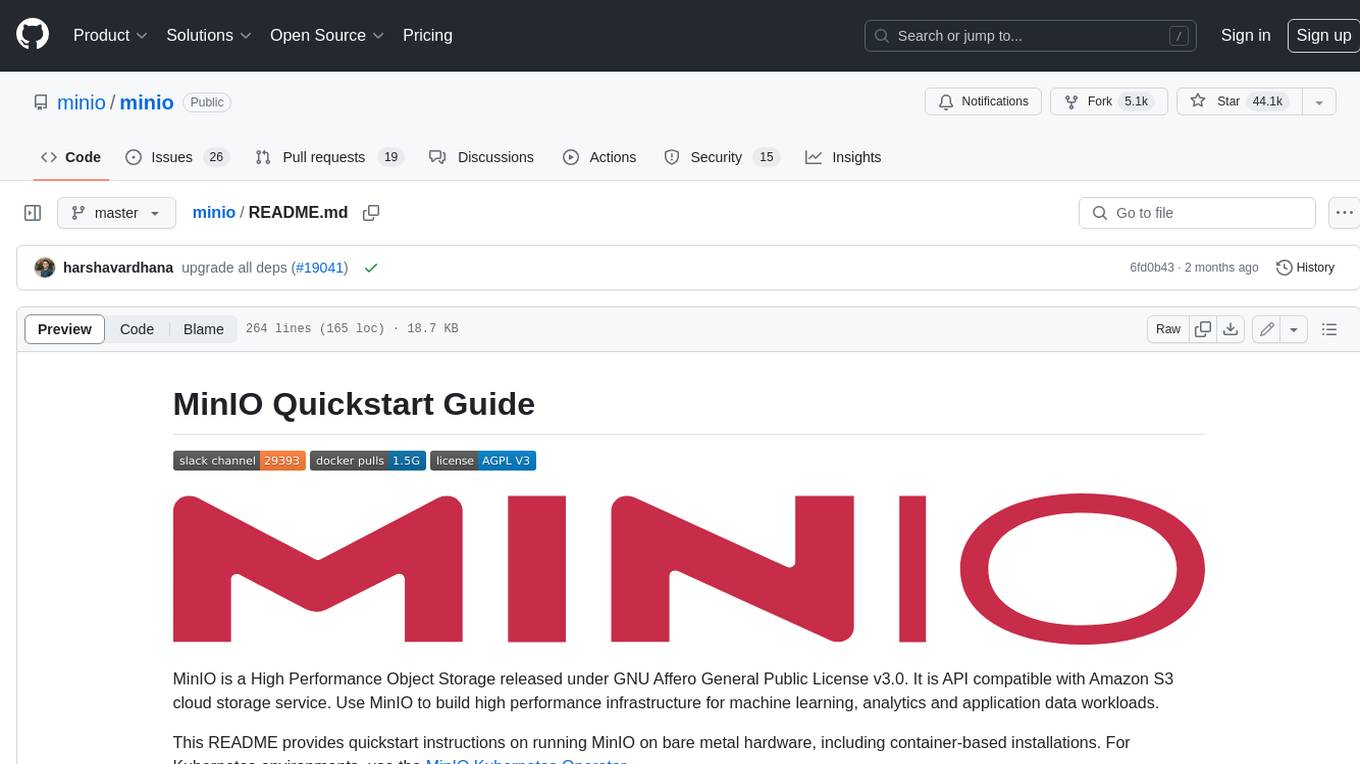
minio
MinIO is a High Performance Object Storage released under GNU Affero General Public License v3.0. It is API compatible with Amazon S3 cloud storage service. Use MinIO to build high performance infrastructure for machine learning, analytics and application data workloads.
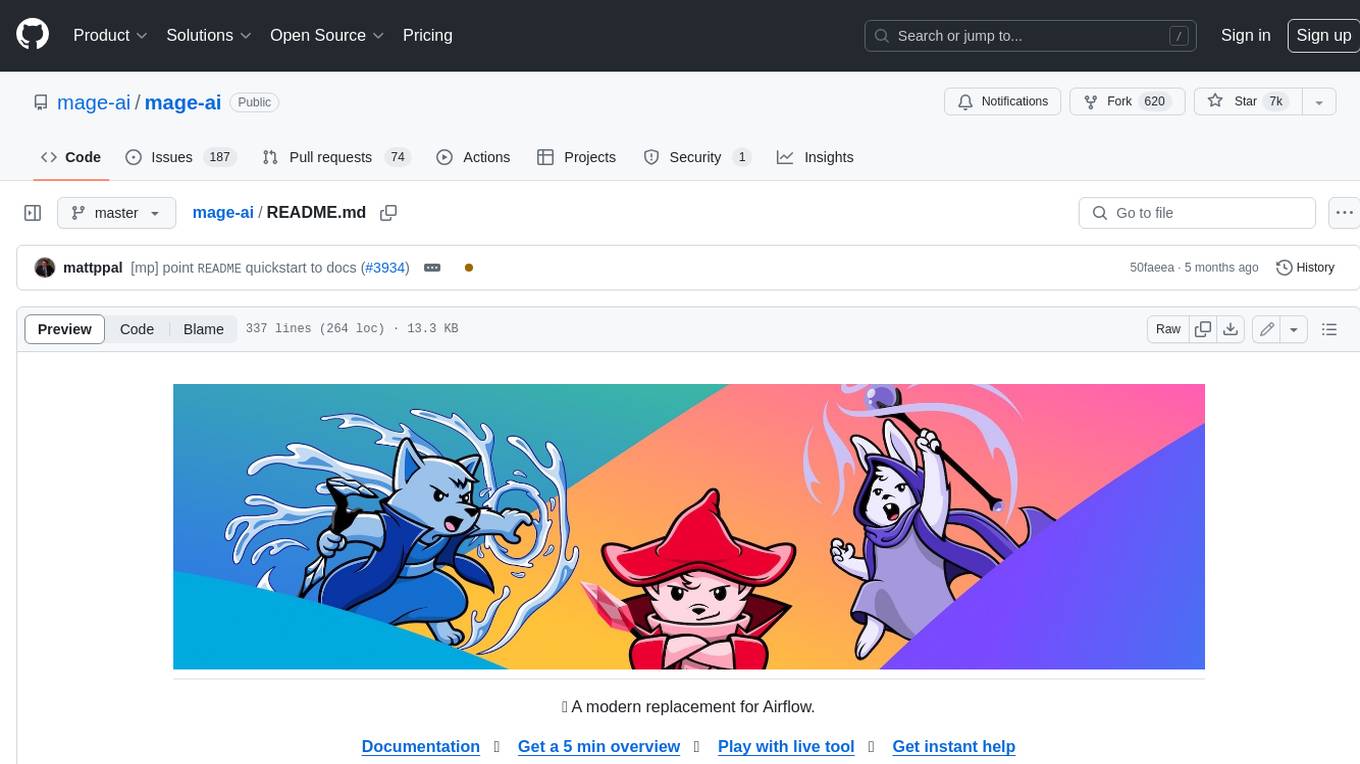
mage-ai
Mage is an open-source data pipeline tool for transforming and integrating data. It offers an easy developer experience, engineering best practices built-in, and data as a first-class citizen. Mage makes it easy to build, preview, and launch data pipelines, and provides observability and scaling capabilities. It supports data integrations, streaming pipelines, and dbt integration.
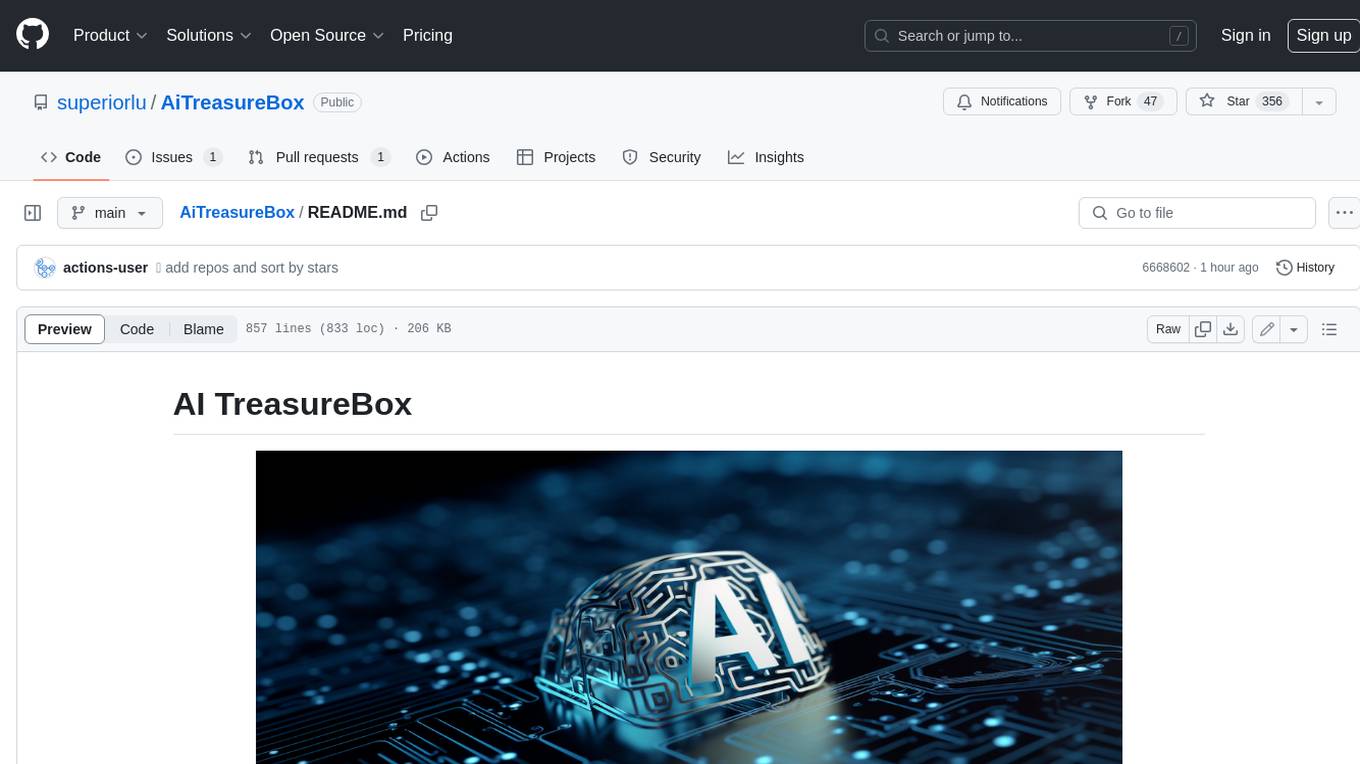
AiTreasureBox
AiTreasureBox is a versatile AI tool that provides a collection of pre-trained models and algorithms for various machine learning tasks. It simplifies the process of implementing AI solutions by offering ready-to-use components that can be easily integrated into projects. With AiTreasureBox, users can quickly prototype and deploy AI applications without the need for extensive knowledge in machine learning or deep learning. The tool covers a wide range of tasks such as image classification, text generation, sentiment analysis, object detection, and more. It is designed to be user-friendly and accessible to both beginners and experienced developers, making AI development more efficient and accessible to a wider audience.

tidb
TiDB is an open-source distributed SQL database that supports Hybrid Transactional and Analytical Processing (HTAP) workloads. It is MySQL compatible and features horizontal scalability, strong consistency, and high availability.
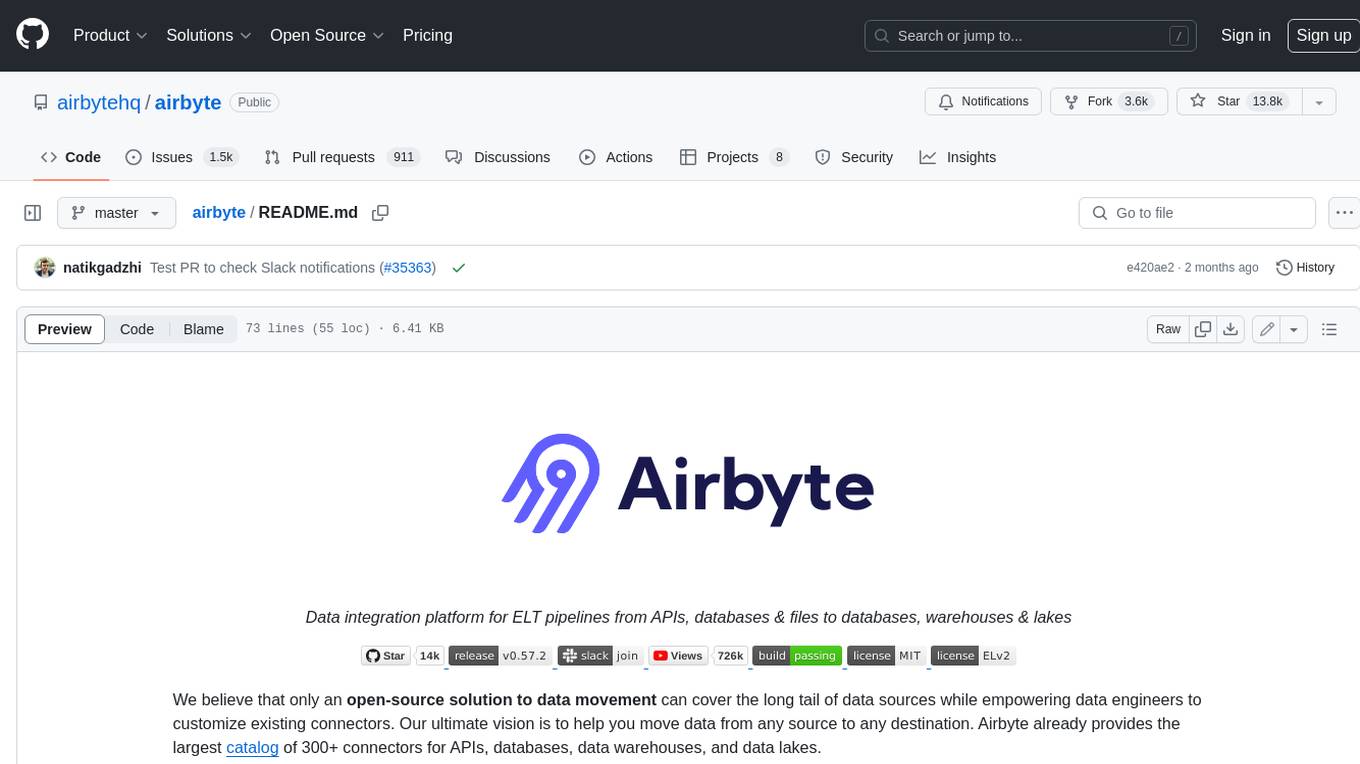
airbyte
Airbyte is an open-source data integration platform that makes it easy to move data from any source to any destination. With Airbyte, you can build and manage data pipelines without writing any code. Airbyte provides a library of pre-built connectors that make it easy to connect to popular data sources and destinations. You can also create your own connectors using Airbyte's no-code Connector Builder or low-code CDK. Airbyte is used by data engineers and analysts at companies of all sizes to build and manage their data pipelines.

labelbox-python
Labelbox is a data-centric AI platform for enterprises to develop, optimize, and use AI to solve problems and power new products and services. Enterprises use Labelbox to curate data, generate high-quality human feedback data for computer vision and LLMs, evaluate model performance, and automate tasks by combining AI and human-centric workflows. The academic & research community uses Labelbox for cutting-edge AI research.



